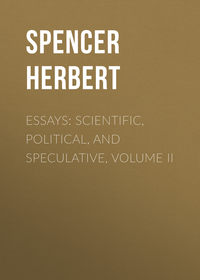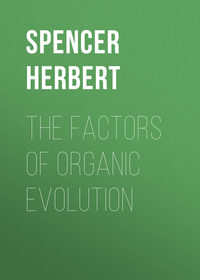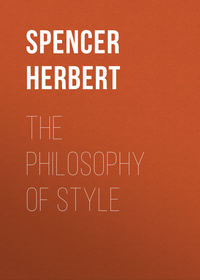 полная версия
полная версияThe Principles of Biology, Volume 1 (of 2)
Whether a nerve is merely a conductor, which delivers at one of its extremities an impulse received at the other, or whether, as some now think, it is itself a generator of force which is initiated at one extremity and accumulates in its course to the other extremity, are questions which cannot yet be answered. All we know is that agencies capable of working molecular changes in nerves are capable of calling forth from them manifestations of activity. And our evidence that nerve-force is thus originated, consists not only of such facts as the above, but also of more conclusive facts established by direct experiments on nerves – experiments which show that nerve-force results when the cut end of a nerve is either mechanically irritated, or acted on by some chemical agent, or subject to the galvanic current – experiments which prove that nerve-force is generated by whatever disturbs the molecular equilibrium of nerve-substance.
§ 22. The most important of the re-actions called forth from organisms by surrounding actions, remains to be noticed. To the various forms of insensible motion thus caused, we have to add sensible motion. On the production of this mode of force more especially depends the possibility of all vital phenomena. It is, indeed, usual to regard the power of generating sensible motion as confined to one out of the two organic sub-kingdoms; or, at any rate, as possessed by but few members of the other. On looking closer into the matter, however, we see that plant-life as well as animal-life, is universally accompanied by certain manifestations of this power; and that plant-life could not otherwise continue.
Through the humblest, as well as through the highest, vegetal organisms, there are ever going on certain re-distributions of matter. In Protophytes the microscope shows us an internal transposition of parts, which, when not immediately visible, is proved to exist by the changes of arrangement that become manifest in the course of hours and days. In the individual cells of many higher plants, an active movement among the contained granules may be witnessed. And well-developed cryptogams, in common with all phanerogams, exhibit this genesis of mechanical motion still more conspicuously in the circulation of sap. It might, indeed, be concluded a priori, that through plants displaying much differentiation of parts, an internal movement must be going on; since, without it, the mutual dependence of organs having unlike functions would be impossible. Besides keeping up these motions of liquids internally, plants, especially of the lower orders, move their external parts in relation to each other, and also move about from place to place. There are countless such illustrations as the active locomotion of the zoospores of many Algæ, the rhythmical bendings of the Oscillatoræ, the rambling progression of the Diatomaceæ. In fact many of these smallest vegetals, and many of the larger ones in their early stages, display a mechanical activity not distinguishable from that of the simplest animals. Among well-organized plants, which are never locomotive in their adult states, we still not unfrequently meet with relative motions of parts. To such familiar cases as those of the Sensitive plant and the Venus' fly-trap, many others may be added. When its base is irritated the stamen of the Berberry flower leans over and touches the pistil. If the stamens of the wild Cistus be gently brushed with the finger, they spread themselves: bending away from the seed-vessel. And some of the orchid-flowers, as Mr. Darwin has shown, shoot out masses of pollen on to the entering bee, when its trunk is thrust down in search of honey.
Though the power of moving is not, as we see, a characteristic of animals alone, yet in them, considered as a class, it is manifested to an extent so marked as practically to become their most distinctive trait. For it is by their immensely greater ability to generate mechanical motion, that animals are enabled to perform those actions which constitute their visible lives; and it is by their immensely greater ability to generate mechanical motion, that the higher orders of animals are most obviously distinguished from the lower orders. Though, on remembering the seemingly active movements of infusoria, some will perhaps question this last-named contrast, yet, on comparing the quantities of matter propelled through given spaces in given times, they will see that the momentum evolved is far less in the Protozoa than in the Metazoa. These sensible motions of animals are effected in sundry ways. In the humblest forms, and even in some of the more developed forms which inhabit the water, locomotion results from the oscillations of whip-like appendages, single or double, or from the oscillations of cilia: the contractility resides in these waving hairs that grow from the surface. In many Cœlenterata certain elongations or tails of ectodermal or endodermal cells shorten when stimulated, and by these rudimentary contractile organs the movements are effected. In all the higher animals, however, and to a smaller degree in many of the lower, sensible motion is generated by a special tissue, under a special excitement. Though it is not strictly true that such animals show no sensible motions otherwise caused, since all of them have certain ciliated membranes, and since the circulation of liquids in them is partially due to osmotic and capillary actions; yet, generally speaking, we may say that their movements are effected solely by muscles which contract solely through the agency of nerves.
What special transformations of force generate these various mechanical changes, we do not, in most cases, know. Those re-distributions of liquid, with the alterations of form sometimes caused by them, that result from osmose, are not, indeed, incomprehensible. Certain motions of plants which, like those of the "animated oat," follow contact with water, are easily interpreted; as are also such other vegetal motions as those of the Touch-me-not, the Squirting Cucumber, and the Carpobolus. But we are ignorant of the mode in which molecular movement is transformed into the movement of masses, in animals. We cannot refer to known causes the rhythmical action of a Medusa's disc, or that slow decrease of bulk which spreads throughout the mass of an Alcyonium when one of its component individuals has been irritated. Nor are we any better able to say how the insensible motion transmitted through a nerve, gives rise to sensitive motion in a muscle. It is true that Science has given to Art several methods of changing insensible into sensible motion. By applying heat to water we vaporize it, and the movement of its expanding vapour we transfer to solid matter; but evidently the genesis of muscular movement is in no way analogous to this. The force evolved in a galvanic battery or by a dynamo, we communicate to a soft iron magnet through a wire coiled round it; and it would be possible, by placing near to each other several magnets thus excited, to obtain, through the attraction of each for its neighbours, an accumulated movement made up of their separate movements, and thus mechanically to imitate a muscular contraction. But from what we know of organic matter there is no reason to suppose that anything analogous to this takes place in it. We can, however, through one kind of molecular change, produce sensible changes of aggregation such as possibly might, when occurring in organic substance, cause sensible motion in it. I refer to change that is allotropic or isomeric. Sulphur, for example, assumes different crystalline and non-crystalline forms at different temperatures, and may be made to pass backwards and forwards from one form to another, by slight variations of temperature: undergoing each time an alteration of bulk. We know that this allotropism, or rather its analogue isomerism, prevails among colloids – inorganic and organic. We also know that some of these metamorphoses among colloids are accompanied by visible re-arrangements: instance hydrated silicic acid, which, after passing from its soluble state to the state of an insoluble jelly, begins, in a few days, to contract and to give out part of its contained water. Now considering that such isomeric changes of organic as well as inorganic colloids, are often rapidly produced by very slight causes – a trace of a neutral salt or a degree or two rise of temperature – it seems not impossible that some of the colloids constituting muscle may be thus changed by a nervous discharge: resuming their previous condition when the discharge ceases. And it is conceivable that by structural arrangements, minute sensible motions so caused may be accumulated into large sensible motions.
§ 23. But the truths which it is here our business especially to note, are independent of hypotheses or interpretations. It is sufficient for the ends in view, to observe that organic matter does exhibit these several conspicuous reactions when acted on by incident forces. It is not requisite that we should know how these re-actions originate.
In the last chapter were set forth the several modes in which incident forces cause re-distributions of organic matter; and in this chapter have been set forth the several modes in which is manifested the motion accompanying this re-distribution. There we contemplated, under its several aspects, the general fact that, in consequence of its extreme instability, organic matter undergoes extensive molecular re-arrangements on very slight changes of conditions. And here we have contemplated, under its several aspects, the correlative general fact that, during these extensive molecular re-arrangements, there are evolved large amounts of energy. In the one case the components of organic matter are regarded as falling from positions of unstable equilibrium to positions of stable equilibrium; and in the other case they are regarded as giving out in their falls certain momenta – momenta that may be manifested as heat, light, electricity, nerve-force, or mechanical motion, according as the conditions determine.
I will add only that these evolutions of energy are rigorously dependent on these changes of matter. It is a corollary from the primordial truth which, as we have seen, underlies all other truths, (First Principles, §§ 62, 189,) that whatever amount of power an organism expends in any shape, is the correlate and equivalent of a power which was taken into it from without. On the one hand, it follows from the persistence of force that each portion of mechanical or other energy which an organism exerts, implies the transformation of as much organic matter as contained this energy in a latent state. And on the other hand, it follows from the persistence of force that no such transformation of organic matter containing this latent energy can take place, without the energy being in one shape or other manifested.
CHAPTER IIIA.
METABOLISM
§ 23a. In the early forties the French chemist Dumas pointed out the opposed actions of the vegetal and animal kingdoms: the one having for its chief chemical effect the decomposition of carbon-dioxide, with accompanying assimilation of its carbon and liberation of its oxygen, and the other having for its chief chemical effect the oxidation of carbon and production of carbon-dioxide. Omitting those plants which contain no chlorophyll, all others de-oxidize carbon; while all animals, save the few which contain chlorophyll, re-oxidize carbon. This is not, indeed, a complete account of the general relation; since it represents animals as wholly dependent on plants, either directly or indirectly through other animals, while plants are represented as wholly independent of animals; and this last representation though mainly true, since plants can obtain direct from the inorganic world certain other constituents they need, is in some measure not true, since many with greater facility obtain these materials from the decaying bodies of animals or from their excreta. But after noting this qualification the broad antithesis remains as alleged.
How are these transformations brought about? The carbon contained in carbon-dioxide does not at a bound become incorporated in the plant, nor does the substance appropriated by the animal from the plant become at a bound carbon-dioxide. It is through two complex sets of changes that these two ultimate results are brought about. The materials forming the tissues of plants as well as the materials contained in them, are progressively elaborated from the inorganic substances; and the resulting compounds, eaten and some of them assimilated by animals, pass through successive changes which are, on the average, of an opposite character: the two sets being constructive and destructive. To express changes of both these natures the term "metabolism" is used; and such of the metabolic changes as result in building up from simple to compound are distinguished as "anabolic," while those which result in the falling down from compound to simple are distinguished as "katabolic." These antithetical names do not indeed cover all the molecular transformations going on. Many of them, known as isomeric, imply neither building up nor falling down: they imply re-arrangement only. But those which here chiefly concern us are the two opposed kinds described.
A qualification is needful. These antithetic changes must be understood as characterizing plant-life and animal-life in general ways rather than in special ways – as expressing the transformations in their totalities but not in their details. For there are katabolic processes in plants, though they bear but a small ratio to the anabolic ones; and there are anabolic processes in animals, though they bear but a small ratio to the katabolic ones.
From the chemico-physical aspect of these changes we pass to those distinguished as vital; for metabolic changes can be dealt with only as changes effected by that living substance called protoplasm.
§ 23b. On the evolution-hypothesis we are obliged to assume that the earliest living things – probably minute units of protoplasm smaller than any the microscope reveals to us – had the ability to appropriate directly from the inorganic world both the nitrogen and the materials for carbo-hydrates without both of which protoplasm cannot be formed; since in the absence of preceding organic matter there was no other source. The general law of evolution as well as the observed actions of Protozoa and Protophyta, suggest that these primordial types simultaneously displayed animal-life and plant-life. For whereas the developed animal-type cannot form from its inorganic surroundings either nitrogenous compounds or carbo-hydrates; and whereas the developed plant-type, able to form carbo-hydrates from its inorganic surroundings, depends for the formation of its protoplasm mainly, although indirectly, on the nitrogenous compounds derived from preceding organisms, as do also most of the plants devoid of chlorophyll – the fungi; we are obliged to assume that in the beginning, along with the expending activities characterizing the animal-type, there went the accumulating activities characterizing both of the vegetal types – forms of activity by-and-by differentiated.
Though the successive steps in the artificial formation of organic compounds have now gone so far that substances simulating proteids, if not identical with them, have been produced, yet we have no clue to the conditions under which proteids arose; and still less have we a clue to the conditions under which inert proteids became so combined as to form active protoplasm. The essential fact to be recognized is that living matter, originated as we must assume during a long stage of progressive cooling in which the infinitely varied parts of the Earth's surface were slowly passing through appropriate physical conditions, possessed from the outset the power of assimilating to itself the materials from which more living matter was formed; and that since then all living matter has arisen from its self-increasing action. But now, leaving speculation concerning these anabolic changes as they commenced in the remote past, let us contemplate them as they are carried on now – first directing our attention to those presented in the vegetal world.
§ 23c. The decomposition of carbon-dioxide (§ 13) – the separation of its carbon from the combined oxygen so that it may enter into one or other form of carbo-hydrate, – is not now ordinarily effected, as we must assume it once was, by the undifferentiated protoplasm; but is effected by a specialized substance, chlorophyll, imbedded in the protoplasm and operating by its instrumentality. The chlorophyll-grain is not simply immersed in protoplasm but is permeated throughout its substance by a protoplasmic network or sponge-work apparently continuous with the protoplasm around; or, according to Sachs, consists of protoplasm holding chlorophyll-particles in suspension: the mechanical arrangement facilitating the chemical function. The resulting abstraction of carbon from carbon-dioxide, by the aid of certain ethereal undulations, appears to be the first step in the building up of organic compounds – the first step in the primary anabolic process. We are not here concerned with details. Two subsequent sets of changes only need here to be noted – the genesis of the passive materials out of which plant-structure is built up, and the genesis of the active materials by which these are produced and the building up effected.
The hydrated carbon which protoplasm, having the chlorophyll-grain as its implement, produces from carbonic acid and water, appears not to be of one kind only. The possible carbo-hydrates are almost infinite in number. Multitudes of them have been artificially made, and numerous kinds are made naturally by plants. Though perhaps the first step in the reduction of the carbon from its dioxide may be always the same, yet it is held probable that in different types of plants different types of carbo-hydrates forthwith arise, and give differential characters to the compounds subsequently formed by such types: sundry of the changes being katabolic rather than anabolic. Of leading members in the group may be named dextrin, starch, and the various sugars characteristic of various plants, as well as the cellulose elaborated by further anabolism. Considered as the kind of carbo-hydrate in which the products of activity are first stored up, to be subsequently modified for divers purposes, starch is the most important of these; and the process of storage is suggested by the structure of the starch-grain. This consists of superposed layers, implying intermittent deposits: the probability being that the variations of light and heat accompanying day and night are associated now with arrest of the deposit and now with recommencement of it. Like in composition as this stored-up starch is with sugar of one or other kind, and capable of being deposited from sugar and again assuming the sugar form, this substance passes, by further metabolism, here into the cellulose which envelopes each of the multitudinous units of protoplasm, there into the spiral fibres, annuli, or fenestrated tubes which, in early stages of tissue-growth, form channels for the sap, and elsewhere into other components of the general structure. The many changes implied are effected in various ways: now by that simple re-arrangement of components known as isomeric change; now by that taking from a compound one of its elements and inserting one of another kind, which is known as substitution; and now by oxidation, as when the oxy-cellulose which constitutes wood-fibre, is produced.
Besides elaborating building materials, the protoplasm elaborates itself – that is, elaborates more of itself. It is chemically distinguished from the building materials by the presence of nitrogen. Derived from atmospheric ammonia, or from decaying or excreted organic matter, or from the products of certain fungi and microbes at its roots, the nitrogen in one or other combination is brought into a plant by the upward current; and by some unknown process (not dependent on light, since it goes on equally well if not better in darkness) the protoplasm dissociates and appropriates this combined nitrogen and unites it with a carbo-hydrate to form one or other proteid – albumen, gluten, or some isomer; appropriating at the same time from certain of the earth-salts the requisite amount of sulphur and in some cases phosphorus. The ultimate step, as we must suppose, is the formation of living protoplasm out of these non-living proteids. A cardinal fact is that proteids admit of multitudinous transformations; and it seems not improbable that in protoplasm various isomeric proteids are mingled. If so, we must conclude that protoplasm admits of almost infinite variations in nature. Of course pari passu with this dual process – augmentation of protoplasm and accompanying production of carbo-hydrates – there goes extension of plant-structure and plant-life.
To these essential metabolic processes have to be added certain ancillary and non-essential ones, ending in the formation of colouring matters, odours, essential oils, acrid secretions, bitter compounds and poisons: some serving to attract animals and others to repel them. Sundry of these appear to be excretions – useless matters cast out, and are doubtless katabolic.
The relation of these facts here sketched in rude outline to the doctrine of Evolution at large should be observed. Already we have seen how (§ 8a), in the course of terrestrial evolution, there has been an increasingly heterogeneous assemblage of increasing heterogeneous compounds, preparing the way for organic life. And here we may see that during the development of plant-life from its lowest algoid and fungoid forms up to those forms which constitute the chief vegetal world, there has been an increasing number of complex organic compounds formed; displayed at once in the diversity of them contained in the same plant and in the still greater diversity displayed in the vast aggregate of species, genera, orders, and classes of plants.
§ 23d. On passing to the metabolism characterizing animal life, which, as already indicated, is in the main a process of decomposition undoing the process of composition characterizing vegetal life, we may fitly note at the outset that it must have wide limits of variation, alike in different classes of animals and even in the same animal.
If we take, on the one hand, a carnivore living on muscular tissue (for wild carnivores preying upon herbivores which can rarely become fat obtain scarcely any carbo-hydrates) and observe that its food is almost exclusively nitrogenous; and if, on the other hand, we take a graminivorous animal the food of which (save when it eats seeds) contains comparatively little nitrogenous matter; we seem obliged to suppose that the parts played in the organic processes by the proteids and the carbo-hydrates can in considerable measures replace one another. It is true that the quantity of food and the required alimentary system in the last case, are very much greater than in the first case. But this difference is mainly due to the circumstance that the food of the graminivorous animal consists chiefly of waste-matter – ligneous fibre, cellulose, chlorophyll – and that could the starch, sugar, and protoplasm be obtained without the waste-matter, the required bulks of the two kinds of food would be by no means so strongly contrasted. This becomes manifest on comparing flesh-eating and grain-eating birds – say a hawk and a pigeon. In powers of flight these do not greatly differ, nor is the size of the alimentary system conspicuously greater in the last than in the first; though probably the amount of food consumed is greater. Still it seems clear that the supply of energy obtained by a pigeon from carbo-hydrates with a moderate proportion of proteids is not widely unlike that obtained by a hawk from proteids alone. Even from the traits of men differently fed a like inference may be drawn. On the one hand we have the Masai who, during their warrior-days, eat flesh exclusively; and on the other hand we have the Hindus, feeding almost wholly on vegetable food. Doubtless the quantities required in these cases differ much; but the difference between the rations of the flesh-eater and the grain-eater is not so immense as it would be were there no substitution in the physiological uses of the materials.
Concerning the special aspects of animal-metabolism, we have first to note those various minor transformations that are auxiliary to the general transformation by which force is obtained from food. For many of the vital activities merely subserve the elaboration of materials for activity at large, and the getting rid of waste products. From blood passing through the salivary glands is prepared in large quantity a secretion containing among other matters a nitrogenous ferment, ptyaline, which, mixed with food during mastication, furthers the change of its starch into sugar. Then in the stomach come the more or less varying secretions known in combination as gastric juice. Besides certain salts and hydrochloric acid, this contains another nitrogenous ferment, pepsin, which is instrumental in dissolving the proteids swallowed. To these two metabolic products aiding solution of the various ingested solids, is presently added that product of metabolism in the pancreas which, added to the chyme, effects certain other molecular changes – notably that of such amylaceous matters as are yet unaltered, into saccharine matters to be presently absorbed. And let us note the significant fact that the preparation of food-materials in the alimentary canal, again shows us that unstable nitrogenous compounds are the agents which, while themselves changing, set up changes in the carbo-hydrates and proteids around: the nitrogen plays the same part here as elsewhere. It does the like in yet another viscus. Blood which passes through the spleen on its way to the liver, is exposed to the action of "a special proteid of the nature of alkali-albumin, holding iron in some way peculiarly associated with it." Lastly we come to that all-important organ the liver, at once a factory and a storehouse. Here several metabolisms are simultaneously carried on. There is that which until recent years was supposed to be the sole hepatic process – the formation of bile. In some liver-cells are masses of oil-globules, which seem to imply a carbo-hydrate metamorphosis. And then, of leading importance, comes the extensive production of that animal-starch known as glycogen – a substance which, in each of the cells generating it, is contained in a plexus of protoplasmic threads: again a nitrogenous body diffused through a mass which is now formed out of sugar and is now dissolved again into sugar. For it appears that this soluble form of carbo-hydrate, taken into the liver from the intestine, is there, when not immediately needed, stored up in the form of glycogen, ready to be re-dissolved and carried into the system either for immediate use or for re-deposit as glycogen at the places where it is presently to be consumed: the great deposit in the liver and the minor deposits in the muscles being, to use the simile of Prof. Michael Foster, analogous in their functions to a central bank and branch banks.









